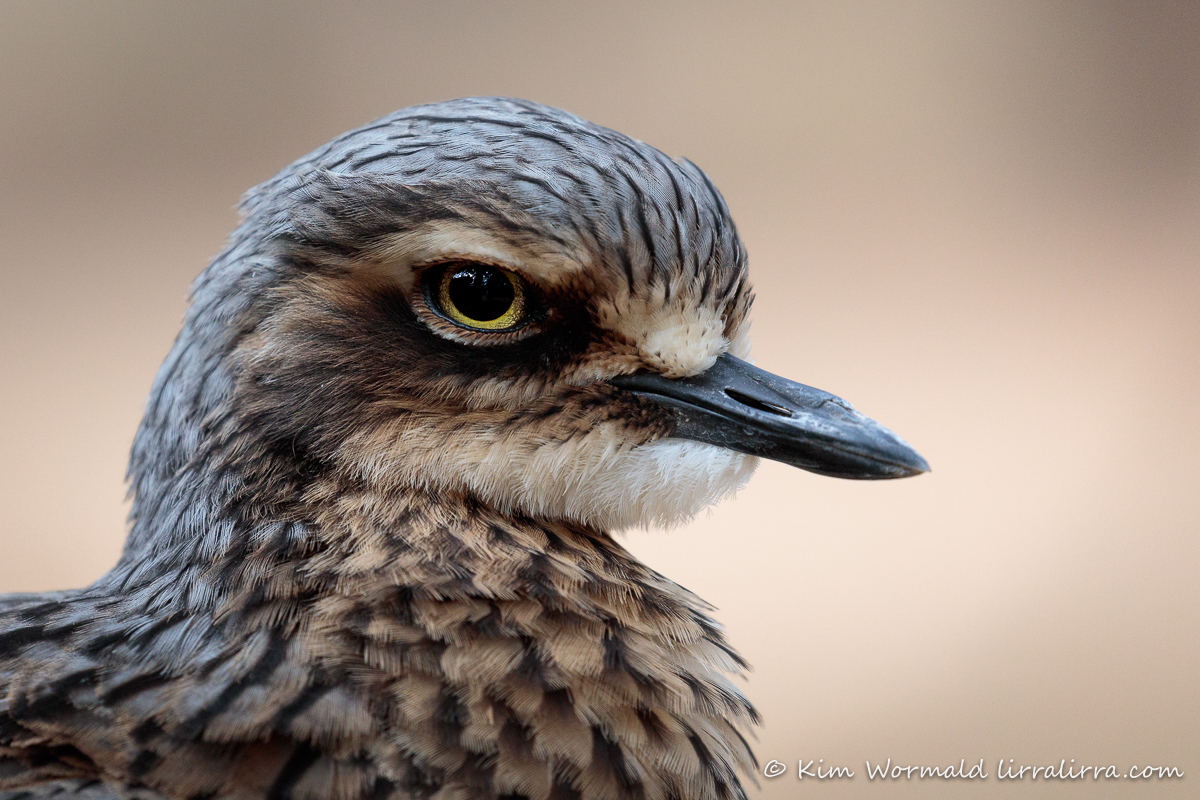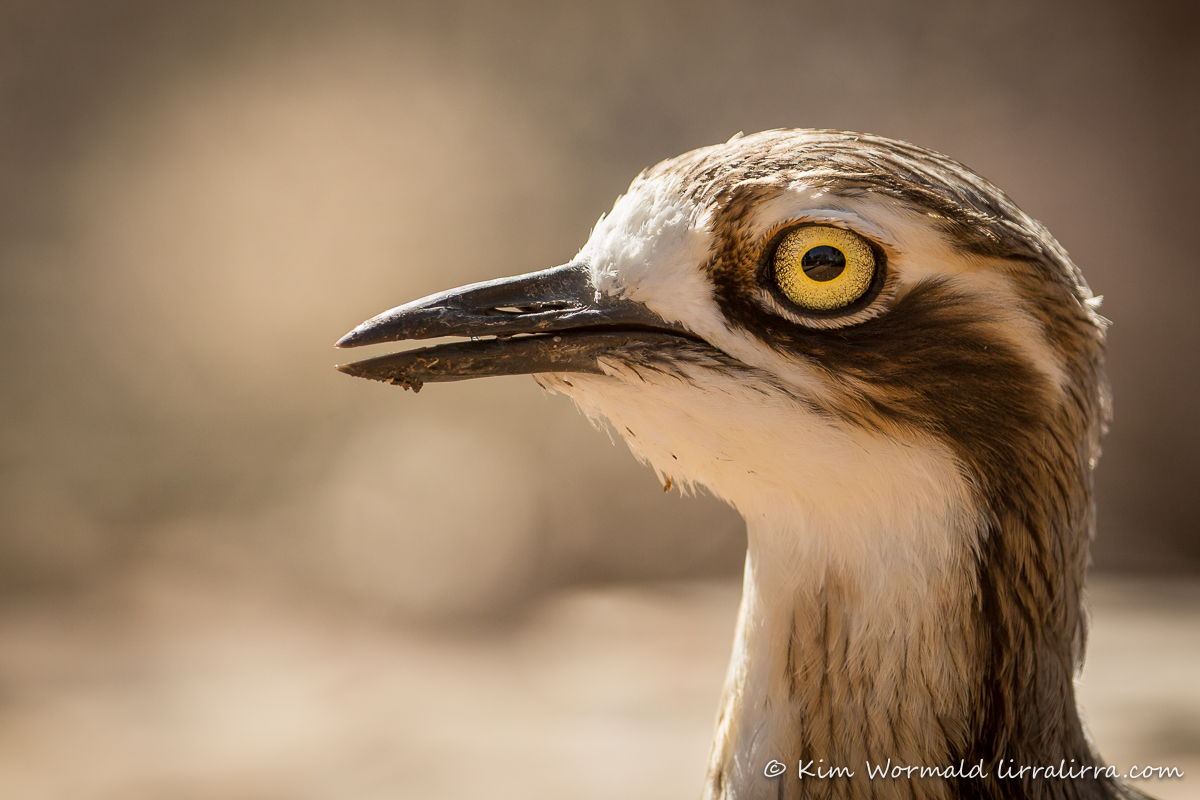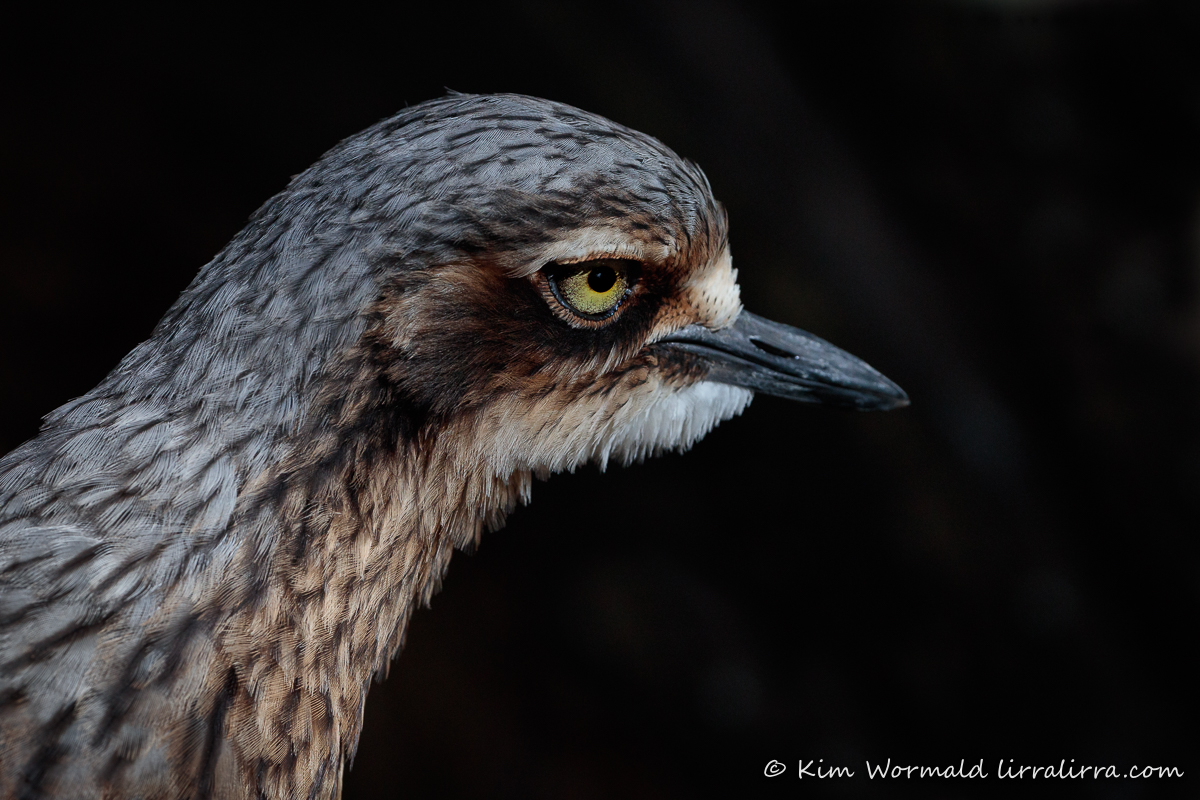This week’s images are of a remarkable species, the Bush Stone-curlew.

1/400, f/5.6, ISO 3200
The eyes of Bush Stone-curlews fascinate me, they are so direct, such a striking colour and fringed with exquisite lashes. Their plumage is also beautiful, a palette of warm whites and soft browns with a hint of black for contrast. The feathers beneath their chins makes me smile. I am especially fond of this species, if you hadn’t already guessed.
The birds in this post were photographed in captivity, one at Serendip and the others at Healesville. An older post shows wild birds that I saw in Queensland. I was thrilled to see them and hadn’t understood at first that they freeze and rely on camouflage to escape detection. It’s a trait that certainly helps to capture photographs while also making them appear bold, which is the impression I always get from the directness of their stare.
 Bush Stone-curlew (Burhinus grallarius)
Bush Stone-curlew (Burhinus grallarius)
1/640, f/7.1, ISO 400
The stone-curlew above is a younger, paler, browner bird. They grow to about 56cm and feed on a range of small creatures along with seeds. They have a remarkable call, a haunting wail that eerily permeates the night as they keep in contact with each other. They are nocturnal and can be found across many parts of mainland Australia although their range is decreasing due to predation by cats and foxes along with habitat destruction. They are considered endangered in Victoria and New South Wales, rare in South Australia and secure in the other states and territories.
 Bush Stone-curlew (Burhinus grallarius)
Bush Stone-curlew (Burhinus grallarius)
1/1000, f/7.1, ISO 1600
I was inspired to re-look at my Bush Stone-curlew images following a email from a reader (hi John) who shared details about the wide range of birds he saw on a recent trip to Queensland. He described the ‘unblinking, baleful gaze’ of the stone-curlews, which sent me straight to Lightroom to look at my images.
My aim has always been to promote awareness about our beautiful birds while remembering that the bird is more important than the image. Accordingly, I’m in the process of developing workshops focussing on ethical bird photography and image evaluation sessions (which can be done remotely). If you are interested in either topic you are welcome to send me a note to hear about the early bird specials.
Happy birding
Kim
~ thank you for visiting and commenting
~ use the subscribe box if you’d like to receive a weekly email when lirralirra is updated

Hi Kim, I am interested in the workshops.
Hi Ann, please send a note to kim@lirralirra.com and I’ll get straight back to you, Kim
Hi Kim…Thanks for the good wishes. I WISH we were in a warmer place right now..still at home…so cold this Winter…motivation to pack etc = zero BUT…we are going on Sunday…come hell or high water…as the saying goes. Planning on spending 4 nights in Charters Towers…looking for the ‘horrible’ bird. Will let you know if I find it.:)
awww my favorite bird…and i am yet to see one in the wild in Victoria …i occasionally hear their cry.
I hadn’t noticed the lashes before …agree they are exquisite
I hope you get to see one in Victoria soon. It must be magical to get the chance to hear them as often as you do.
We’re fortunate to have several pair close by our town in nth Vic. Their existence is a closely guarded secret amongst the farmers who own their habitat and local naturalists and birdwatchers who watch them from a distance.. We had Chris Tzaros, ex-Birdlife ecologist, visit us for a walk and talk two months ago , and we had 50 interested people attend. A local farmer has a pair near his old sheds , and bingo, on arrival everyone got fabulous views of the pair. After about seven minutes they flew off to land in a more treed area close to the creek but still visible. Sadly they are a rare sighting now in Victoria. If you ever get to nth of Shepparton, give me a hoy and I can put you onto landholders who have them still existing close by
How wonderful that the farmers, birders and naturalists are all standing together to protect the stone-curlews. What a buzz it would have been for everyone to get such awesome, long views of the birds. Thank you so much for your kind offer, can you let me know what time of year you think would be best for a visit? My email address is kim@lirralirra.com
Great shots
Thanks Stephen!
Your portraits are superb. And capture the beauty of these birds sooooo well.
Thank you.
And hooray for ethical living and photography.
Thank you EC
Wow they do have attitude! Gorgeous images
I want to go and find some more now, they really do have some crazy expressions
Hi Kim, lovely photos…they are an interesting bird. I first heard them somewhere in Qld a couple of years ago…can’t remember when. We were staying in a caravan park…somewhere..one of the people staying in the park told us not to worry if we heard ‘screams’ in the night…it was only the neighbourhood bush curlews down the road…On a quiet night they are rather loud. Heading up there in a few days…maybe we will hear them again. I am also looking forward to hearing that ‘Horrible’ bird that I told you about…hoping to stay at Charters Towers for a few days..that is where I first heard their ‘Horrible’ calls. I will record the call if I hear them again…I would love to know which bird makes that call.
Hi Carole! I hope you’re up there in the warm now, hearing all kinds of interesting birds. And I hope you get some recordings of the ‘horrible’ bird, that has me really curious. Have a wonderful trip
Wow I didn’t know about the book! Very cool. And I love the sound of the workshops!
I was pretty busy when the book happened and I think I forgot to mention it to anyone, it was good to find it
Wonderfully clear images Kim. These profile shots bring out the rather haunted look in the eyes of these wonderfully quaint birds. I’ve not heard their call in the wild, but its description as being like the call of someone being murdered goes with their quizzical gaze.
Thanks Neil. Their call must give people the shivers the first time they hear it. I wonder if the police ever get called out to investigate.